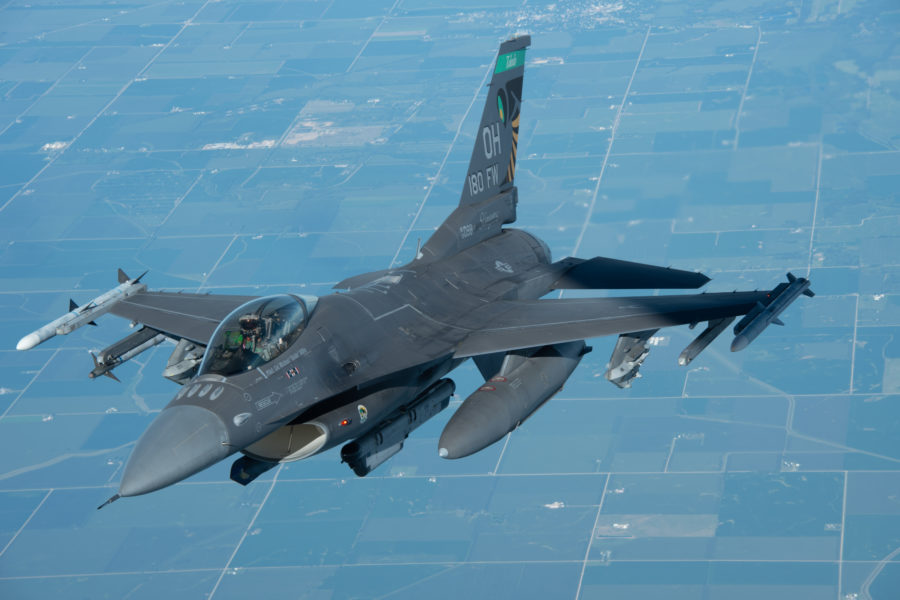Ukraine is stepping up its appeals for modern fighter jets now that the U.S and NATO allies have agreed to send main battle tanks to help counter Russia’s stepped up ground attacks, a Ukrainian official said.
“Until today, the major focus in the discussions have been the tanks,” Yuriy Sak, an advisor to Ukraine’s defense minister Oleksii Reznikov told Air & Space Forces Magazine. “Now we’ll start talking about jets.”
American-made F-16s top Ukraine’s wish list. Swedish-made Gripens, designed to operate from spartan airfields with a limited support crew, as well as other fourth-generation fighters also would be welcomed by Kyiv, but Sak said Ukraine’s hope is that Washington will eventually support the transfer of F-16s.
“F-16[s] are best suited for our situations,” Sak said.
Ukraine has repeatedly asked for Western jets since the start of the war. It has also sought longer-distance ATACMS surface-to-surface missiles. But the Biden administration so far has held the line at weapons with the reach to take the war beyond Ukraine’s borders, fearing such a move might be seen by the Russians as escalatory, leading to a direct clash between U.S. and Russian forces.
Deputy Pentagon press secretary Sabrina Singh said in a Jan. 26 briefing that F-16s were “another challenging system that would require training,” noting that even if the aircraft were provided, it would take time for Ukraine’s pilots to become proficient enough for combat.
The U.S. and its partners have gradually expanded the types of weapons systems provided to Ukraine, and some weapons that the West initially declined to provide have, ultimately, been offered, including the PATRIOT air defense system and M1 tanks. Ukrainian troops are training to operate PATRIOT at Fort Sill, Okla. The Netherlands and Germany have since also pledged to provide PATRIOT systems.
Just a week after the Pentagon strongly argued the case against providing Abrams M1 tanks, President Biden decided to do so anyway after Germany declined to send or allow others to send German-made Leopard 2 tanks to Ukraine unless the U.S. offered its own M1s.
It’s not yet clear where those tanks will come from. General Dynamics could produce new tanks or refurbish existing tanks from the U.S. inventory. Either way, it will take months if not a year before the M1s arrive, making them arrive too late for any sort of spring offensive. But the U.S. no longer seems concerned that the Abrams can’t be supported by Ukraine.
“The Ukrainians have proven that they can learn complicated, complex, challenging systems,” Singh said.
Airpower
Plans to bolster Ukraine’s air forces are still unclear, but the issue is becoming a major concern.
“Unless Ukraine acquires a replacement fighter force of Western origin in the coming months, it will lose the ability to defend its airspace and support its ground forces, and without control of their airspace they will lose,” said retired Lt. Gen. David A. Deptula, dean of AFA’s Mitchell Institute for Aerospace Studies. “Some have raised the practical challenges of pilot training, supply, maintenance, etc. The Ukrainian Air Force can overcome these challenges.”
Air power analysts have said providing Western aircraft and more advanced air-to-air missiles are essential to enabling Ukraine to defend its cities and infrastructure against punishing missile and Shahed drone attacks.
“The Ukrainian Air Force fighter force needs modern Western fighters and missiles to sustainably counter the VKS,” the Royal United Services Institute (RUSI) wrote in a November report, referring to the Russian Aerospace Forces. “Russian pilots have been cautious throughout the war, so even a small number of Western fighters could have a major deterrent effect.”
Justin Bronk, a co-author of that report, said in an interview that the addition of Western fighters would provide Ukraine with a “much better ability” to defend against Russian air threats and cruise missile and drone attacks.
Due to Russia’s air defenses, he said, providing the aircraft to Ukraine “would not be a decisive battlefield swing in terms of their ability to conduct air support.”
The most significant threat to Ukrainian aircraft, according to RUSI, are Russian S-400 surface-to-air missile sites deployed in Russian-occupied Crimea and Belarus, which has forced Ukrainian pilots to fly low to avoid detection. This would likely still be the case even if Ukraine was provided with Western fourth-generation fighters.
“I think it’s really crucial to understand the constraints that will be placed by dense and in some cases very long-range Russian ground-based threats,” Bronk said. “They would all have great difficulty operating above very low level within tens of kilometers from the frontline. So they would have to stay low. That would greatly constrain their weapons employment and their sensor picture options.”
The U.S. has provided Ukraine’s Air Force with AGM-88 HARM air-to-surface anti-radiation missiles that can be used against surface-to-air missile sites. Recently, the U.S. has added more strike capability by providing 4,000 Zuni rocket aircraft rockets, a legacy U.S. weapon that carries a small warhead as well as providing an unspecified number of JDAM precision-guided bombs. But defense officials have repeatedly said that providing aircraft is not a priority for the Biden administration.
The U.S. and its allies decision to provide infantry fighting vehicles, armed personnel carriers, and main battle tanks is intended to help Ukraine make a push to regain more ground. The U.S. is also conducting combined arms training in Europe to help Ukraine employ those capabilities by training Ukraine troops in tactics used by Western militaries.
But the U.S. does not fight a war without air power, and Ukraine has been pleading for Western jets for many months.
To be most effective, Bronk said, Western aircraft should be paired with modern air-to-air missiles, such as the AIM-120 AMRAAM. He cautioned, however, there are technology security concerns if missiles that miss their target fall into Russian hands.
“There’s a big question mark on sensitivity about whether we would even be willing to provide those things,” he said.
